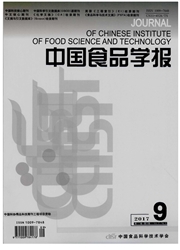

 中文摘要:
中文摘要:
以调控氧化鸡脂为代表,通过固相微萃取/气-质联机对比分析氧化或未氧化鸡脂添加于单纯酶解液中,添加于含有葡萄糖和半胱氨酸的酶解液中,两类热反应产物的挥发性成分变化,研究氧化脂肪的存在对热反应肉味香精制备体系"肉酶解液-半胱氨酸-还原糖"风味形成的影响。结果表明,氧化或未氧化脂肪的存在使挥发性肉香成分总量增加,其中硫醇类化合物含量降低,某些杂环化合物的含量升高,出现新的杂环化合物2,5-二丙基噻吩,以及大量脂肪族醛、酮、醇、酸、内酯等成分。相比之下,氧化脂肪对反应产物风味的影响比未氧化脂肪大;酶解液中半胱氨酸和葡萄糖存在时,脂肪氧化与美拉德反应的作用更为显著。与先前采用"半胱氨酸-还原糖"模型反应相比,在含有酶解液的热反应香精制备体系中添加氧化或未氧化鸡脂时,2-甲基-3-巯基呋喃、糠硫醇等重要肉香味物质的含量降低趋势减弱。
 英文摘要:
英文摘要:
The effect of oxidized and non-oxidized fat on the formation of meat flavor in a thermal reaction flavoring preparation system were studied. Using chicken fat as a representative, volatiles from two kinds of thermal reaction systems, hydrolyzed chicken protein with or without oxidized(or non-oxidized) chicken fat, and hydrolyzed chicken protein containing cysteine and glucose with or without oxidized(or non-oxidized) chicken fat, were comparatively analyzed by solid phase micro-extraction(SPME) in combination with gas chromatography and mass spectrometry(GC-MS). It proved that the inclusion of oxidized or non-oxidized chicken fat caused the total amount of the volatile flavor compounds increased, the amount of the thiol compounds were decreased, the amount of some heterocyclic compounds were increased,and a heterocyclic compound of 2,5-dipropylthiophene and a large number of aliphatic aldehydes, alcohols, acids, and lactones emerged. Compared with non-oxidized fat, the effect of the oxidized fat was stronger. With cysteine and reducing sugars added in the hydrolyzed chicken protein, the interaction of lipid oxidation and degradation with Maillard reaction was increased. In comparison with previous studies using the model reaction of ‘cysteine-reducing sugar' on the effect of oxidized and non-oxidized fat on the formation of meat flavor, for the meat flavorings preparation system the interaction of lipid oxidization and degradation with the Maillard reaction of cysteine and glucose was attenuated due to the presence of hydrolyzed animal protein, leading to the amount of thiols such as 2-methyl-3-furanthiol and 2-furfurylthiol, which are important meaty flavor compounds, being less reduced.
 同期刊论文项目
同期刊论文项目
 同项目期刊论文
同项目期刊论文
 Resolution of racemic gamma-lactone flavors on Chiralpak AD by packed column supercritical fluid chr
Resolution of racemic gamma-lactone flavors on Chiralpak AD by packed column supercritical fluid chr Preparative separation and purification of alkylamides from Zanthoxylum bungeanum Maxim by high-spee
Preparative separation and purification of alkylamides from Zanthoxylum bungeanum Maxim by high-spee Resolution of racemic 3-hydroxy-4,5-dimethyl-2(5H)-furanone (sotolon) by packed column supercritical
Resolution of racemic 3-hydroxy-4,5-dimethyl-2(5H)-furanone (sotolon) by packed column supercritical 期刊信息
期刊信息
